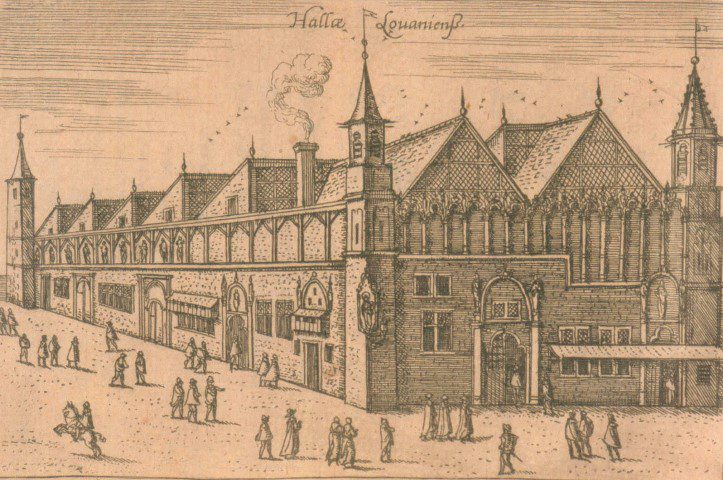Wyn Beasley
Wellington, New Zealand

The Witing family—or Witjing or Witincx; spelling was capricious in those days—originated in Wesel, at the junction of the Rhine and Lippe rivers, and its members were court physicians. Peter is supposed to have attended the Emperor Frederik III, who reigned 1440-1493, and he translated a treatise of Avicenna, which became a family treasure.
Peter’s son Johannes came to Louvain [Leuven] University in 1429, just four years after its foundation. (Fig. 1) Here he was known to the students as Wesalius (“the man from Wesel”), and he appropriated the name. He held various university posts until 1440, when he was appointed physician to the city of Brussels. Until his retirement in 1471, he combined this post with that of physician to Charles the Bold of Burgundy. Family tradition had it that he looked after Charles’s only child, Mary. She was married, young, to the Emperor’s son Maximilian, and this would account for the imperial grant of arms that Johannes received: On a black field, three white [or silver] weasels in pale.
In his latter years Johannes contented himself with being a courtier, passing his responsibilities as court physician to his son Everard. Regrettably, Everard got a girl named Margaretha Winters “into trouble”: the product of this affair was Andreas Vesalius I who, tainted by bastardy, could not hope to follow his father Everard as court physician.

Instead he became a pharmacist and, in time, court dispenser to Margaret of Austria and later to her nephew, the Emperor Charles V. He made himself so indispensable as to dare to ask the Emperor to legitimize him. On October 18, 1531 Charles granted the request of “notre bien aimé varlet de chambre et appoticaire Andries de Wesele”—and he did it without fee! By this time Andreas had married Isabella Crabbe. They had four children: three sons, Nicolas, Andreas II (our Andreas, the future anatomist; born on December 31, 1514), Frans; and daughter Anna.
Free of his grandfather’s disgrace, Andreas junior launched himself into a brilliant career—after an arts course at Louvain, where the university and town had both flourished since his great-grandfather’s time, he moved to Paris in 1533 for his medical studies. Paris was a conservative institution, its anatomy teaching rigidly Galenic. Vesalius once remarked that he had never seen his teacher Guenther of Andernach with a knife in his hand except at table carving the venison. But he was popular with the faculty, and he himself performed the third dissection to occur during his three years in Paris. Before he could graduate war broke out between the French king and the Emperor, and Paris was no good place for men with imperial connections; so Guenther returned to his native Strasbourg and young Vesalius went home briefly to Brussels, before returning to Louvain, where his most notable exploit was to remove, in several trips, the bones of a skeleton he found on the public gibbet outside the town. He was subsequently permitted to perform public dissections, but these brought him into debate with local theologians, and he prudently moved on—to Basel where he became acquainted with the publisher Robert Winter, and thence to Venice, where he met Jan Stephan van Calcar, who would produce the plates for the Fabrica.
He graduated in Padua almost at once, and was forthwith appointed to a chair in anatomy (and shortly also in surgery). From his experience with the Tabulae sex, produced as a teaching aid, came the Fabrica—with its large format and plates that were works of art; and through his friend Winter in Basel he secured the services of Johannes Herbst [known as Oporinus] to be his publisher.
Ever since Paracelsus, who was a mountebank and a rebel but no fool, had startled orthodox medicine by adding the works of Avicenna to a public bonfire there, Basel had been regarded as a place of intellectual ferment, and suited to a work such as the Fabrica, which upset, indeed denied, a good deal of traditional wisdom.
The book came out in 1543, a year of scientific revolt. The title page emphasizes both the originality of the work and the personalities involved: here is no medieval professor high in his pulpit while a flunkey carries out the actual dissection, but the working anatomist—recognizably Vesalius himself—in the midst of things; and above, the three weasels in pale of his arms; while two observers in the gallery have been identified as van Calcar the artist and his master Titian. And the emblem ф [the Greek ‘phi’] on the back wall of the gallery: does this stand for Ioannes Oporinus of Basel?
WYN BEASLEY, CNZM, OBE, ED, FRCSEng, FRCSEd, FRACS, FACS, is an orthopedic surgeon who has turned in retirement to the writing of history, and has been a regular contributor to a number of journals. His ninth book, Churchill: the supreme survivor, was launched in London in October 2013.

Leave a Reply